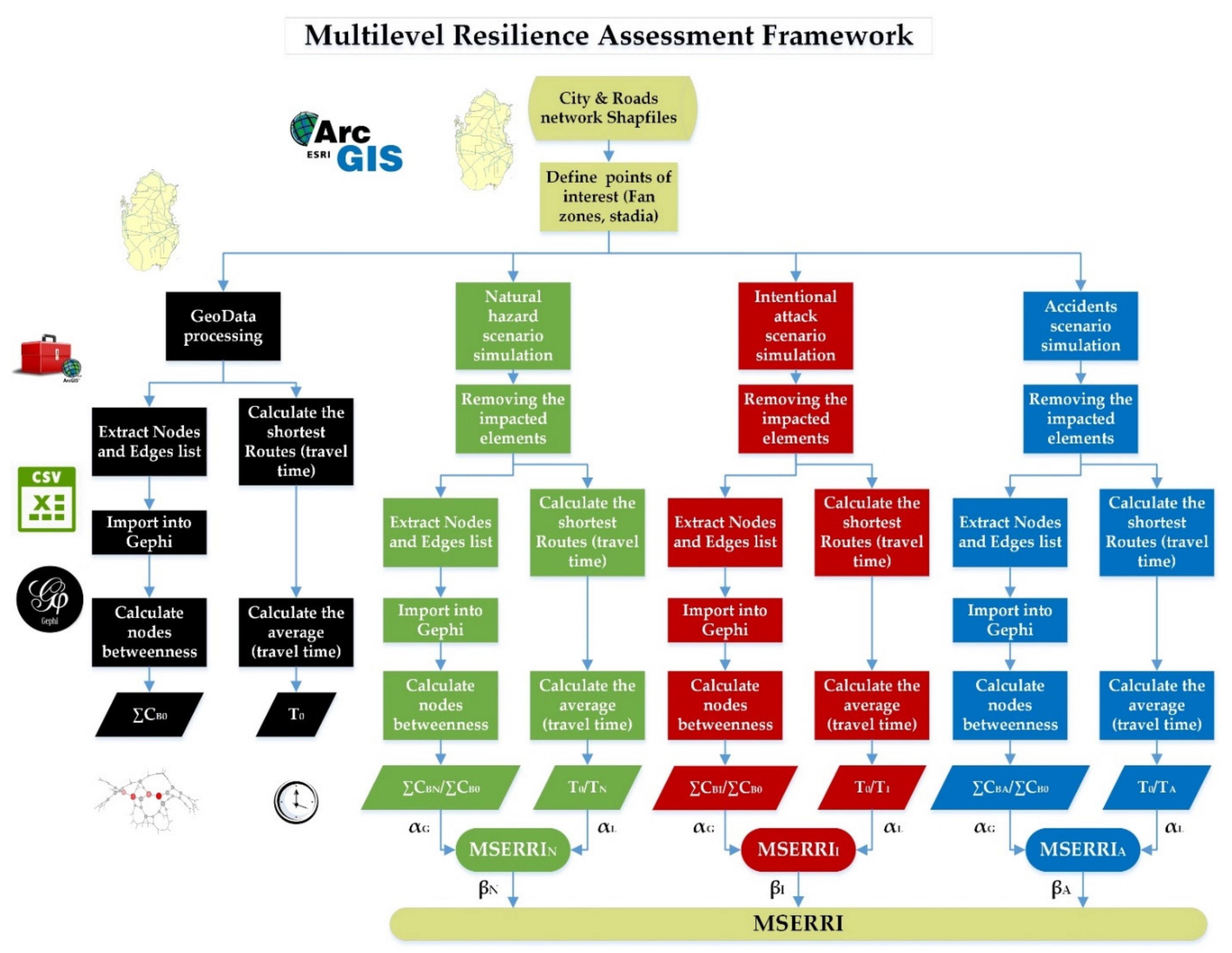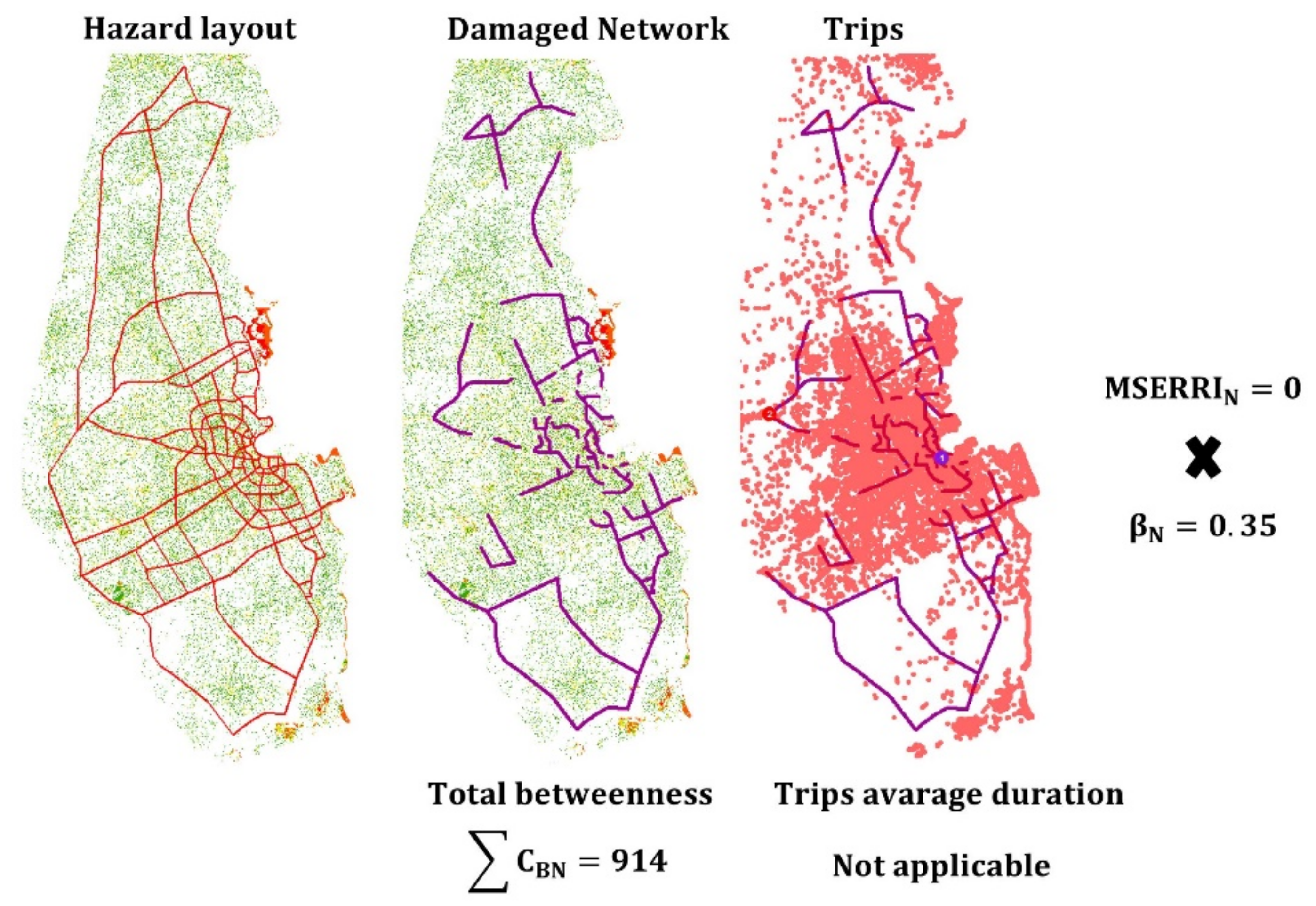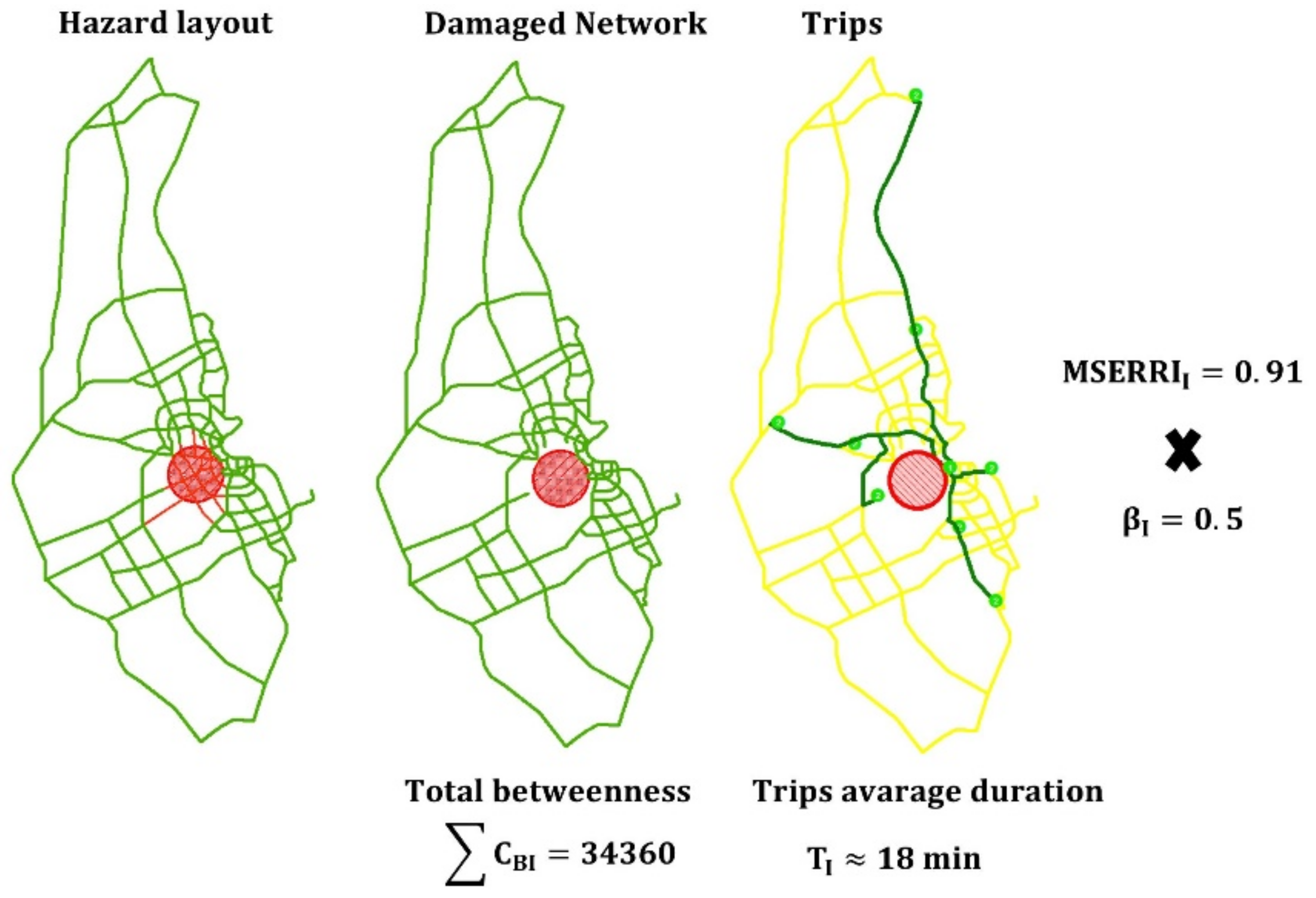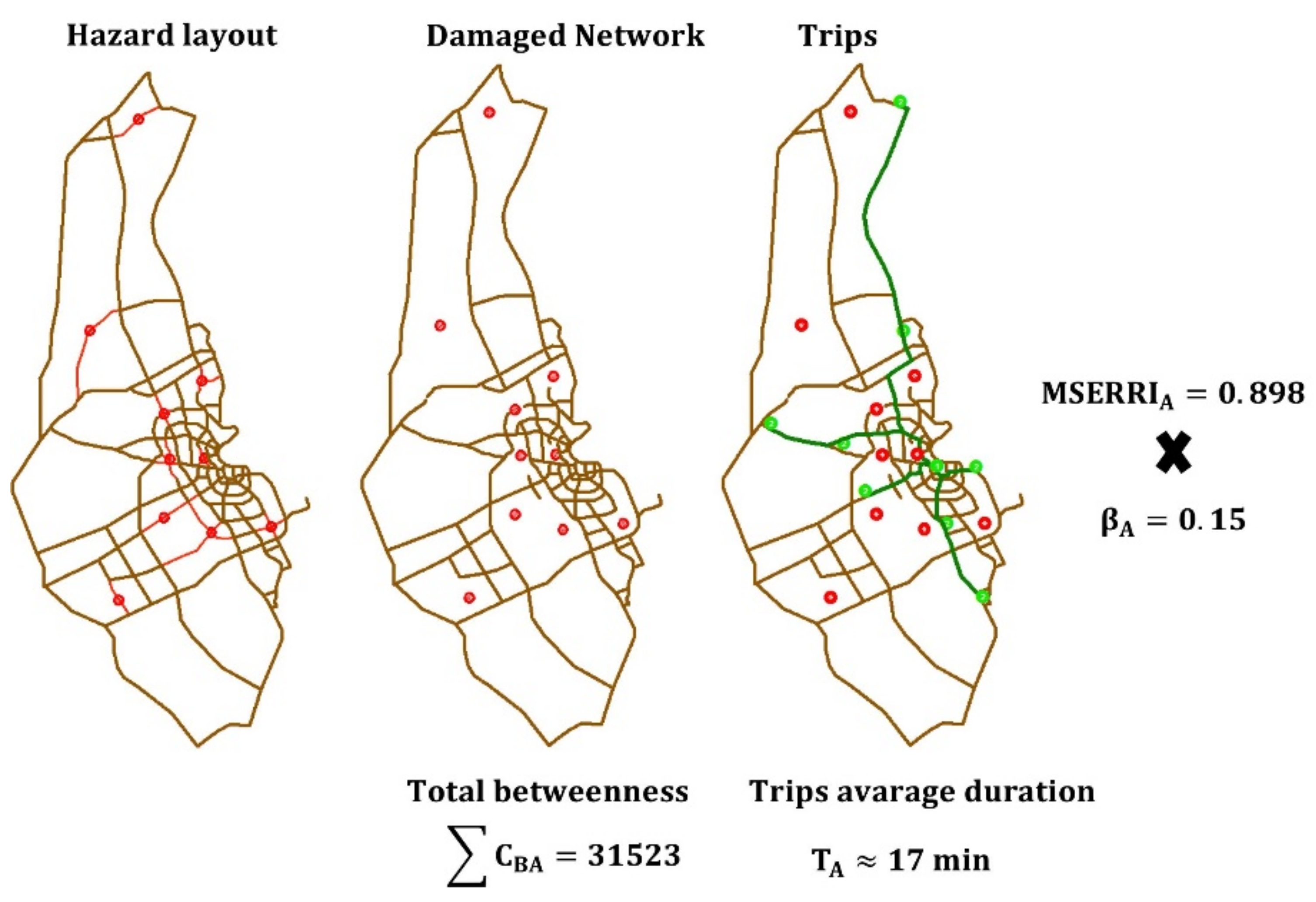Resiliency Assessment of Road Networks during Mega Sport Events: The Case of FIFA World Cup Qatar 2022
Abstract
:1. Introduction
1.1. Resiliency in Transportation Systems
1.2. Mega Sports Events and Resilience
2. Methods
2.1. Multilevel Resiliency Assessment
- : is the betweenness centrality of node (i),
- : is the number of shortest paths that start at node (s) and ends at node (t), and
- : is the number of these shortest paths that pass through the node (i).
2.2. Disturbance Scenarios
2.3. Case Study Description
3. Results and Discussion
3.1. Doha Is Vulnerable to Flooding Hazards
3.2. Doha Road Network Is Resilient to Intentional Attacks
3.3. Doha Road Network Is Resilient to Accidents (Random Widespread Failures)
4. Conclusions and Outlook
Author Contributions
Funding
Institutional Review Board Statement
Informed Consent Statement
Data Availability Statement
Conflicts of Interest
References
- United Nations, Department of Economic and Social Affairs. World Urbanization Prospects: The 2018 Revision; United Nations: New York, NY, USA, 2019. [Google Scholar]
- Addanki, S.C.; Venkataraman, H. Greening the economy: A review of urban sustainability measures for developing new cities. Sustain. Cities Soc. 2017, 32, 1–8. [Google Scholar] [CrossRef]
- Liu, W.; Song, Z. Review of studies on the resilience of urban critical infrastructure networks. Reliab. Eng. Syst. Saf. 2020, 193, 106617. [Google Scholar] [CrossRef]
- The Resilience Shift. The Resilience Shift Website. Available online: http://resilienceshift.org (accessed on 18 November 2019).
- Duy, P.N.; Chapman, L.; Tight, M. Resilient transport systems to reduce urban vulnerability to floods in emerging-coastal cities: A case study of Ho Chi Minh City, Vietnam. Travel Behav. Soc. 2019, 15, 28–43. [Google Scholar] [CrossRef]
- Huck, A.; Monstadt, J. Urban and infrastructure resilience: Diverging concepts and the need for cross-boundary learning. Environ. Sci. Policy 2019, 100, 211–220. [Google Scholar] [CrossRef]
- Ilbeigi, M. Statistical process control for analyzing resilience of transportation networks. Int. J. Disaster Risk Reduct. 2019, 33, 155–161. [Google Scholar] [CrossRef]
- Schleussner, C.-F.; Donges, J.F.; Donner, R.V.; Schellnhuber, H.J. Armed-conflict risks enhanced by climate-related disasters in ethnically fractionalized countries. Proc. Natl. Acad. Sci. USA 2016, 113, 9216–9221. [Google Scholar] [CrossRef] [Green Version]
- Salimi, M.; Al-Ghamdi, S.G. Climate change impacts on critical urban infrastructure and urban resiliency strategies for the Middle East. Sustain. Cities Soc. 2020, 54, 101948. [Google Scholar] [CrossRef]
- Raleigh, C. Political Marginalization, Climate Change, and Conflict in African Sahel States. Int. Stud. Rev. 2010, 12, 69–86. [Google Scholar] [CrossRef]
- Raouf, A.M.; Al-Ghamdi, S.G. Effectiveness of Project Delivery Systems in Executing Green Buildings. J. Constr. Eng. Manag. 2019, 145, 03119005. [Google Scholar] [CrossRef]
- Wan, C.; Yang, Z.; Zhang, D.; Yan, X.; Fan, S. Resilience in transportation systems: A systematic review and future directions. Transp. Rev. 2018, 38, 479–498. [Google Scholar] [CrossRef]
- Meza Talavera, A.; Al-Ghamdi, S.; Koç, M. Sustainability in Mega-Events: Beyond Qatar 2022. Sustainability 2019, 11, 6407. [Google Scholar] [CrossRef] [Green Version]
- Holling, C.S. Resilience and Stability of Ecological Systems. Annu. Rev. Ecol. Syst. 1973, 4, 1–23. [Google Scholar] [CrossRef] [Green Version]
- Chan, R.; Schofer, J.L. Measuring Transportation System Resilience: Response of Rail Transit to Weather Disruptions. Nat. Hazards Rev. 2016, 17, 05015004. [Google Scholar] [CrossRef]
- Abedi, A.; Gaudard, L.; Romerio, F. Review of major approaches to analyze vulnerability in power system. Reliab. Eng. Syst. Saf. 2019, 183, 153–172. [Google Scholar] [CrossRef]
- Hosseini, S.; Barker, K.; Ramirez-Marquez, J.E. A review of definitions and measures of system resilience. Reliab. Eng. Syst. Saf. 2016, 145, 47–61. [Google Scholar] [CrossRef]
- Bruneau, M.; Chang, S.E.; Eguchi, R.T.; Lee, G.C.; O’Rourke, T.D.; Reinhorn, A.M.; Shinozuka, M.; Tierney, K.; Wallace, W.A.; Von Winterfeldt, D. A Framework to Quantitatively Assess and Enhance the Seismic Resilience of Communities. Earthq. Spectra 2003, 19, 733–752. [Google Scholar] [CrossRef] [Green Version]
- Faturechi, R.; Miller-Hooks, E. Measuring the Performance of Transportation Infrastructure Systems in Disasters: A Comprehensive Review. J. Infrastruct. Syst. 2015, 21, 04014025. [Google Scholar] [CrossRef]
- Gasser, P.; Suter, J.; Cinelli, M.; Spada, M.; Burgherr, P.; Hirschberg, S.; Kadziński, M.; Stojadinović, B. Comprehensive resilience assessment of electricity supply security for 140 countries. Ecol. Indic. 2020, 110, 105731. [Google Scholar] [CrossRef]
- Najafi, J.; Peiravi, A.; Anvari-Moghaddam, A.; Guerrero, J.M. Resilience improvement planning of power-water distribution systems with multiple microgrids against hurricanes using clean strategies. J. Clean. Prod. 2019, 223, 109–126. [Google Scholar] [CrossRef]
- Chakrabarti, S. Eutrophication—A Global Aquatic Environmental Problem: A Review. Res. Rev. J. Ecol. Environ. Sci. 2018, 6, 1–6. [Google Scholar]
- Meng, Y.; Yang, Y.; Chung, H.; Lee, P.-H.; Shao, C. Enhancing Sustainability and Energy Efficiency in Smart Factories: A Review. Sustainability 2018, 10, 4779. [Google Scholar] [CrossRef] [Green Version]
- Ferrari, P. The dynamics of the competition between cars and trucks on motorways. Transp. Res. Part C Emerg. Technol. 2011, 19, 579–592. [Google Scholar] [CrossRef]
- Serulle, N.U.; Heaslip, K.; Brady, B.; Louisell, W.C.; Collura, J. Resiliency of Transportation Network of Santo Domingo, Dominican Republic. Transp. Res. Rec. J. Transp. Res. Board 2011, 2234, 22–30. [Google Scholar] [CrossRef]
- Casalicchio, E.; Galli, E.; Tucci, S. Agent-based modelling of interdependent critical infrastructures. Int. J. Syst. Syst. Eng. 2010, 2, 60. [Google Scholar] [CrossRef] [Green Version]
- Sun, W.; Bocchini, P.; Davison, B.D. Resilience metrics and measurement methods for transportation infrastructure: The state of the art. Sustain. Resilient Infrastruct. 2020, 5, 168–199. [Google Scholar] [CrossRef]
- Donovan, B.; Work, D.B. Empirically quantifying city-scale transportation system resilience to extreme events. Transp. Res. Part C Emerg. Technol. 2017, 79, 333–346. [Google Scholar] [CrossRef] [Green Version]
- Serdar, M.Z.; Koç, M.; Al-Ghamdi, S.G. Urban Transportation Networks Resilience: Indicators, Disturbances, and Assessment Methods. Sustain. Cities Soc. 2021, 76, 103452. [Google Scholar] [CrossRef]
- Aydin, N.Y.; Duzgun, H.S.; Heinimann, H.R.; Wenzel, F.; Gnyawali, K.R. Framework for improving the resilience and recovery of transportation networks under geohazard risks. Int. J. Disaster Risk Reduct. 2018, 31, 832–843. [Google Scholar] [CrossRef]
- Wang, Y.; Zhan, J.; Xu, X.; Li, L.; Chen, P.; Hansen, M. Measuring the resilience of an airport network. Chinese J. Aeronaut. 2019, 32, 2694–2705. [Google Scholar] [CrossRef]
- Liao, T.-Y.; Hu, T.-Y.; Ko, Y.-N. A resilience optimization model for transportation networks under disasters. Nat. Hazards 2018, 93, 469–489. [Google Scholar] [CrossRef]
- Sommer, M.; Tomforde, S.; Hähner, J. An Organic Computing Approach to Resilient Traffic Management. In Autonomic Road Transport Support Systems; Springer International Publishing: Cham, Switzerland, 2016; pp. 113–130. [Google Scholar]
- Ye, Q.; Ukkusuri, S.V. Resilience as an Objective in the Optimal Reconstruction Sequence for Transportation Networks. J. Transp. Saf. Secur. 2015, 7, 91–105. [Google Scholar] [CrossRef]
- Haznagy, A.; Fi, I.; London, A.; Nemeth, T. Complex network analysis of public transportation networks: A comprehensive study. In Proceedings of the 2015 International Conference on Models and Technologies for Intelligent Transportation Systems (MT-ITS), Budapest, Hungary, 3–5 June 2015; IEEE: Piscataway, NJ, USA, 2015; pp. 371–378. [Google Scholar]
- Zhang, J.; Wang, S.; Wang, X. Comparison analysis on vulnerability of metro networks based on complex network. Phys. A Stat. Mech. Appl. 2018, 496, 72–78. [Google Scholar] [CrossRef]
- Zhenwu, S.; Xianyu, T.; Huiyu, L.; Hui, L.; Jie, L.; Xunguo, L. Quantitative Study on the Waterlogging Resilience of Road Transportation System Based on the Validity View of System Functions. J. Eng. Sci. Technol. Rev. 2019, 12, 117–125. [Google Scholar] [CrossRef]
- Cerqueti, R.; Ferraro, G.; Iovanella, A. Measuring network resilience through connection patterns. Reliab. Eng. Syst. Saf. 2019, 188, 320–329. [Google Scholar] [CrossRef] [Green Version]
- Testa, A.C.; Furtado, M.N.; Alipour, A. Resilience of Coastal Transportation Networks Faced with Extreme Climatic Events. Transp. Res. Rec. J. Transp. Res. Board 2015, 2532, 29–36. [Google Scholar] [CrossRef]
- Bell, M.G.H. Measuring network reliability: A game theoretic approach. J. Adv. Transp. 1999, 33, 135–146. [Google Scholar] [CrossRef]
- Akbarzadeh, M.; Memarmontazerin, S.; Derrible, S.; Salehi Reihani, S.F. The role of travel demand and network centrality on the connectivity and resilience of an urban street system. Transportation 2019, 46, 1127–1141. [Google Scholar] [CrossRef]
- Cheng, M.X.; Crow, M.; Ye, Q. A game theory approach to vulnerability analysis: Integrating power flows with topological analysis. Int. J. Electr. Power Energy Syst. 2016, 82, 29–36. [Google Scholar] [CrossRef] [Green Version]
- Sarlas, G.; Páez, A.; Axhausen, K.W. Betweenness-accessibility: Estimating impacts of accessibility on networks. J. Transp. Geogr. 2020, 84, 102680. [Google Scholar] [CrossRef]
- Ortega, E.; Martín, B.; Aparicio, Á. Identification of critical sections of the Spanish transport system due to climate scenarios. J. Transp. Geogr. 2020, 84, 102691. [Google Scholar] [CrossRef]
- Twumasi-Boakye, R.; Sobanjo, J.O. Resilience of Regional Transportation Networks Subjected to Hazard-Induced Bridge Damages. J. Transp. Eng. Part A Syst. 2018, 144, 04018062. [Google Scholar] [CrossRef] [Green Version]
- Yang, Y.; Ng, S.T.; Zhou, S.; Xu, F.J.; Li, H. Physics-driven based resilience analysis of interdependent civil infrastructure systems—A Case study in Hong Kong. In Proceedings of the Computing in Civil Engineering 2019, Atlanta, GA, USA, 17–19 June 2019; American Society of Civil Engineers: Reston, VA, USA, 2019; pp. 563–569. [Google Scholar]
- Pagani, G.A.; Aiello, M. A complex network approach for identifying vulnerabilities of the medium and low voltage grid. Int. J. Crit. Infrastruct. 2015, 11, 36. [Google Scholar] [CrossRef]
- Zio, E.; Golea, L.R. Analyzing the topological, electrical and reliability characteristics of a power transmission system for identifying its critical elements. Reliab. Eng. Syst. Saf. 2012, 101, 67–74. [Google Scholar] [CrossRef] [Green Version]
- Cuadra, L.; Salcedo-Sanz, S.; Del Ser, J.; Jiménez-Fernández, S.; Geem, Z. A Critical Review of Robustness in Power Grids Using Complex Networks Concepts. Energies 2015, 8, 9211–9265. [Google Scholar] [CrossRef] [Green Version]
- Preuss, H. The Contribution of the FIFA World Cup and the Olympic Games to Green Economy. Sustainability 2013, 5, 3581–3600. [Google Scholar] [CrossRef] [Green Version]
- Borchers, M.; Kedia, S.; Trusen, C. Sustainable Mega-Events in Developing Countries: Experiences and Insights from Host Cities in South Africa, India and Brazil; Konrad Adenauer Stiftung: Johannesburg, South Africa, 2011; ISBN 978-0-9870243-0-5. [Google Scholar]
- The Supreme Committee for Delivery and Legacy. The Supreme Committee for Delivery and Legacy (Sustainability Policy). Available online: https://www.qatar2022.qa/en/about/sustainability (accessed on 10 October 2020).
- Azzali, S. Mega-events and urban planning: Doha as a case study. URBAN Des. Int. 2017, 22, 3–12. [Google Scholar] [CrossRef]
- Weiler, J.; Mohan, A. The Olympic Games and the Triple Bottom Line of Sustainability: Opportunities and Challenges. Int. J. Sport Soc. 2010, 1, 187–202. [Google Scholar] [CrossRef] [Green Version]
- Butry, D.; Davis, C.A.; Malushte, S.R.; Medina, R.A.; Taha, M.R.; van de Lindt, J.W.; Brett, C.R.; Daghash, S.; Field, C.; Fung, J.; et al. Hazard-Resilient Infrastructure; Ayyub, B.M., Ed.; American Society of Civil Engineers: Reston, VA, USA, 2021; ISBN 9780784415757. [Google Scholar]
- Serdar, M.Z.; Koc, M.; Al-Ghamdi, S.G. Urban Infrastructure Resilience Assessment During Mega Sport Events Using a Multi-Criteria Approach. Front. Sustain. 2021, 2, 41. [Google Scholar] [CrossRef]
- Serdar, M.Z.; Al-Ghamdi, S.G. Preparing for the Unpredicted: A Resiliency Approach in Energy System Assessment. In Green Energy and Technology; Ren, J., Ed.; Springer International Publishing: Cham, Switzerland, 2021; pp. 183–201. ISBN 978-3-030-67529-5. [Google Scholar]
- Yadav, N.; Chatterjee, S.; Ganguly, A.R. Resilience of Urban Transport Network-of-Networks under Intense Flood Hazards Exacerbated by Targeted Attacks. Sci. Rep. 2020, 10, 10350. [Google Scholar] [CrossRef]
- Zhang, D.; Du, F.; Huang, H.; Zhang, F.; Ayyub, B.M.; Beer, M. Resiliency assessment of urban rail transit networks: Shanghai metro as an example. Saf. Sci. 2018, 106, 230–243. [Google Scholar] [CrossRef]
- Soltani-Sobh, A.; Heaslip, K.; El Khoury, J. Estimation of road network reliability on resiliency: An uncertain based model. Int. J. Disaster Risk Reduct. 2015, 14, 536–544. [Google Scholar] [CrossRef]
- Ukkusuri, S.V.; Yushimito, W.F. A methodology to assess the criticality of highway transportation networks. J. Transp. Secur. 2009, 2, 29–46. [Google Scholar] [CrossRef]
- Yin, Y.; Ieda, H. Assessing Performance Reliability of Road Networks Under Nonrecurrent Congestion. Transp. Res. Rec. J. Transp. Res. Board 2001, 1771, 148–155. [Google Scholar] [CrossRef]
- Casali, Y.; Heinimann, H.R. Robustness response of the Zurich road network under different disruption processes. Comput. Environ. Urban Syst. 2020, 81, 101460. [Google Scholar] [CrossRef]
- Freeman, L.C. Centrality in social networks conceptual clarification. Soc. Netw. 1978, 1, 215–239. [Google Scholar] [CrossRef] [Green Version]
- Pregnolato, M.; Ford, A.; Robson, C.; Glenis, V.; Barr, S.; Dawson, R. Assessing urban strategies for reducing the impacts of extreme weather on infrastructure networks. R. Soc. Open Sci. 2016, 3, 160023. [Google Scholar] [CrossRef] [Green Version]
- Karduni, A.; Kermanshah, A.; Derrible, S. A protocol to convert spatial polyline data to network formats and applications to world urban road networks. Sci. Data 2016, 3, 160046. [Google Scholar] [CrossRef]
- Bastian, M.; Heymann, S.; Jacomy, M. Gephi: An open source software for exploring and manipulating networks. In Proceedings of the BT—International AAAI Conference on Weblogs and Social Media, San Jose, CA, USA, 17–20 May 2009; pp. 361–362. [Google Scholar]
- Kermanshah, A.; Derrible, S. Robustness of road systems to extreme flooding: Using elements of GIS, travel demand, and network science. Nat. Hazards 2017, 86, 151–164. [Google Scholar] [CrossRef]
- Flood Hazard Map-FEMA. Available online: https://hazards-fema.maps.arcgis.com/apps/webappviewer/index.html?id=8b0adb51996444d4879338b5529aa9cd (accessed on 28 September 2021).
- Kermanshah, A.; Karduni, A.; Peiravian, F.; Derrible, S. Impact analysis of extreme events on flows in spatial networks. In Proceedings of the 2014 IEEE International Conference on Big Data (Big Data), Washington, DC, USA, 27–30 October 2014; IEEE: Piscataway, NJ, USA, 2014; pp. 29–34. [Google Scholar]
- MME. MME Flood Mapping Portal. Available online: https://aldeera.gisqatar.org.qa/mmeflood/ (accessed on 29 April 2021).
- Ser-Giacomi, E.; Baudena, A.; Rossi, V.; Follows, M.; Clayton, S.; Vasile, R.; López, C.; Hernández-García, E. Lagrangian betweenness as a measure of bottlenecks in dynamical systems with oceanographic examples. Nat. Commun. 2021, 12, 4935. [Google Scholar] [CrossRef]
- Teixeira, A.S.; Santos, F.C.; Francisco, A.P. Spanning edge betweenness in practice. In Complex Networks VII; Springer International Publishing: Cham, Switzerland, 2016; pp. 3–10. [Google Scholar]
- Derrible, S. Network centrality of metro systems. PLoS ONE 2012, 7, e40575. [Google Scholar] [CrossRef] [Green Version]





| Case | Betweenness | Travel Time (Min.) | MSERRI | ||
|---|---|---|---|---|---|
| Max (% Change) | Sum (% Change) | Max (% Change) | Average (% Change) | ||
| Baseline | 1085 | 37,194 | 43.5 | 16 | - |
| Scenario #1 | 103 (−90%) | 914 (−97.5%) | - | - | 0.00 |
| Scenario #2 | 1242 (+14.5%) | 34,360 (−7.6%) | 43.5 | 18 (+12.5%) | 0.91 |
| Scenario #3 | 1228 (+13.2%) | 31,523 (−15.2%) | 46.1 (+5.8%) | 17 (+6.25%) | 0.9 |
Publisher’s Note: MDPI stays neutral with regard to jurisdictional claims in published maps and institutional affiliations. |
© 2021 by the authors. Licensee MDPI, Basel, Switzerland. This article is an open access article distributed under the terms and conditions of the Creative Commons Attribution (CC BY) license (https://creativecommons.org/licenses/by/4.0/).
Share and Cite
Serdar, M.Z.; Al-Ghamdi, S.G. Resiliency Assessment of Road Networks during Mega Sport Events: The Case of FIFA World Cup Qatar 2022. Sustainability 2021, 13, 12367. https://doi.org/10.3390/su132212367
Serdar MZ, Al-Ghamdi SG. Resiliency Assessment of Road Networks during Mega Sport Events: The Case of FIFA World Cup Qatar 2022. Sustainability. 2021; 13(22):12367. https://doi.org/10.3390/su132212367
Chicago/Turabian StyleSerdar, Mohammad Zaher, and Sami G. Al-Ghamdi. 2021. "Resiliency Assessment of Road Networks during Mega Sport Events: The Case of FIFA World Cup Qatar 2022" Sustainability 13, no. 22: 12367. https://doi.org/10.3390/su132212367
APA StyleSerdar, M. Z., & Al-Ghamdi, S. G. (2021). Resiliency Assessment of Road Networks during Mega Sport Events: The Case of FIFA World Cup Qatar 2022. Sustainability, 13(22), 12367. https://doi.org/10.3390/su132212367







